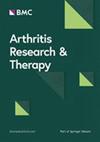Treg cells mitigate inflammatory responses and symptoms via β2-AR/β-Arr2/ERK signaling in an experimental rheumatoid arthritis
IF 4.6
2区 医学
Q1 Medicine
引用次数: 0
Abstract
β2-adrenergic receptor (β2-AR) is widely expressed on immune cells, including T cells and it has a non-canonical signaling pathway, which is β2-AR-β-arrestin 2 (β-Arr2)-extracellular signal-regulated kinase 1/2 (ERK1/2). Our previous studies have shown that the β2-AR agonist terbutaline (Terb) can activate β2-AR and significantly inhibit helper T (Th) 17 cell function in collagen-induced arthritis (CIA). However, the effects of β2-AR on regulatory T (Treg) cells in CIA have not been consistently determined. The aim of our research was to explore whether β2-AR-β-Arr2-ERK1/2 signaling in Treg cells regulates inflammatory responses and signs in CIA. DBA1/J mice were used to prepare CIA model by intradermal injection of collagen type II (CII). Inducible Treg (iTreg) cells were induced from CD4+ T cells that were isolated from the spleens of normal or CIA mice and treated with Terb, β-Arr2 gene silence or overexpression or the ERK1/2 inhibitor U0126 in vitro. β2-AR and β-Arr2 expression, pERK1/2 level, interleukin (IL)-10 and transforming growth factor (TGF)-β production and the suppression of effector T (Teff) cell proliferation mediated by nature Treg (nTreg) cells were determined. β-Arr2-overexpressed Treg cells were intravenously injected into the tail base of CIA mice. Arthritic symptoms were assessed by clinical arthritis scores. Frequencies of Th17 and Treg cells, cytokine production and osteoclast and osteoblast-specific gene expression were estimated. The increased β-Arr2 expression and pERK1/2 level induced by Terb in CIA iTregs were reduced by β-Arr2 gene silence. The increased TGF-β and IL-10 production in iTreg cells by Terb and the suppression of Teff cell proliferation mediated by Terb-treated nTregs from CIA mice were downregulated by β-Arr2 gene silence or U0126 and further enhanced by β-Arr2 gene overexpression. Adoptive transfer of β-Arr2-overexpressed Treg cells into CIA mice reduced limb inflammation, osteoclast-specific gene expression in joints and Th17 cell cytokine production in joints and serum but increased osteoblast-specific gene expression in joints and Treg cell cytokine production in joints and serum. β2-AR/β-Arr2/ERK signaling in Treg cells contributes to alleviation of inflammatory responses and symptoms in CIA.实验性类风湿关节炎中Treg细胞通过β2-AR/β-Arr2/ERK信号通路减轻炎症反应和症状
β2-肾上腺素能受体(β2-AR)广泛表达于包括T细胞在内的免疫细胞上,具有非典型信号通路,即β2-AR-β-阻滞蛋白2 (β-Arr2)-细胞外信号调节激酶1/2 (ERK1/2)。我们之前的研究表明,β2-AR激动剂特布他林(terbutaline, Terb)可以激活β2-AR,并显著抑制胶原诱导关节炎(CIA)的辅助性T (Th) 17细胞功能。然而,β2-AR对CIA调节性T (Treg)细胞的影响尚未得到一致的确定。我们的研究目的是探讨Treg细胞中的β2-AR-β-Arr2-ERK1/2信号是否调节CIA的炎症反应和体征。用DBA1/J小鼠皮内注射II型胶原(CII)制备CIA模型。从正常或CIA小鼠脾脏中分离CD4+ T细胞,用Terb、β-Arr2基因沉默或过表达或ERK1/2抑制剂U0126体外诱导Treg (iTreg)细胞。测定β2-AR和β-Arr2的表达、pERK1/2水平、白细胞介素(IL)-10和转化生长因子(TGF)-β的产生以及天然Treg (nTreg)细胞对效应T (Teff)细胞增殖的抑制作用。将β- arr2过表达的Treg细胞静脉注射到CIA小鼠尾基。通过临床关节炎评分评估关节炎症状。估计Th17和Treg细胞的频率,细胞因子的产生以及破骨细胞和成骨细胞特异性基因的表达。Terb诱导的CIA iTregs中β-Arr2表达升高和pERK1/2水平升高均因β-Arr2基因沉默而降低。Terb增加iTreg细胞TGF-β和IL-10的产生,Terb处理的CIA小鼠nTregs对Teff细胞增殖的抑制作用可通过β-Arr2基因沉默或U0126下调,并通过β-Arr2基因过表达进一步增强。将β- arr2过表达的Treg细胞过代转染CIA小鼠,可降低肢体炎症、关节中破骨细胞特异性基因表达以及关节和血清中Th17细胞细胞因子的产生,但增加关节中成骨细胞特异性基因表达以及关节和血清中Treg细胞细胞因子的产生。Treg细胞中的β2-AR/β-Arr2/ERK信号有助于缓解CIA的炎症反应和症状。
本文章由计算机程序翻译,如有差异,请以英文原文为准。
求助全文
约1分钟内获得全文
求助全文
来源期刊

Arthritis Research & Therapy
RHEUMATOLOGY-
CiteScore
8.60
自引率
2.00%
发文量
261
审稿时长
14 weeks
期刊介绍:
Established in 1999, Arthritis Research and Therapy is an international, open access, peer-reviewed journal, publishing original articles in the area of musculoskeletal research and therapy as well as, reviews, commentaries and reports. A major focus of the journal is on the immunologic processes leading to inflammation, damage and repair as they relate to autoimmune rheumatic and musculoskeletal conditions, and which inform the translation of this knowledge into advances in clinical care. Original basic, translational and clinical research is considered for publication along with results of early and late phase therapeutic trials, especially as they pertain to the underpinning science that informs clinical observations in interventional studies.
 求助内容:
求助内容: 应助结果提醒方式:
应助结果提醒方式:


